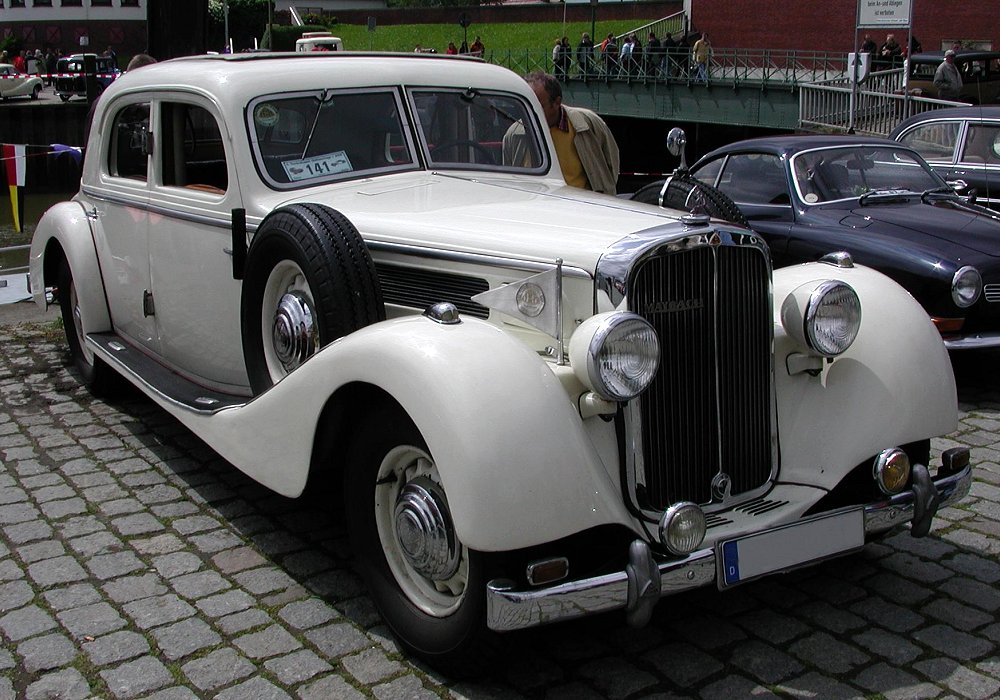Description
The Maybach SW 42, introduced in 1939, was the final and most advanced model in Maybach’s SW-series — a line of technically sophisticated luxury automobiles that had begun with the SW 35 and evolved through the SW 38. The SW 42 represented the pinnacle of Maybach’s pre-war engineering, combining a larger and more powerful straight-six engine with the company’s highly refined independent suspension system and a wide range of bespoke coachbuilt bodies. It stood alongside the magnificent DS “Zeppelin” series as one of the most prestigious German luxury cars of its era and demonstrated Maybach’s commitment to innovation, refinement and mechanical excellence.
At the heart of the SW 42 was its enlarged 4.2-litre straight-six engine. Like the earlier SW engines, it featured a clutch-engaged Roots-type supercharger, which boosted output to approximately 160–170 horsepower depending on tuning. This made it one of the most powerful six-cylinder luxury engines available before the war. The engine’s character was defined by its remarkable smoothness and effortless torque delivery, traits inherited from Maybach’s background in aero-engine construction. Even with large and heavy coachwork, the SW 42 was capable of strong acceleration and sustained high cruising speeds, all delivered with a level of refinement that placed it among the finest luxury cars of the time.
The chassis design was one of the model’s strongest assets. The SW 42 continued to use Maybach’s advanced independent suspension layout, with the Schwingachse swing-axle system at the rear and independent suspension at the front. This gave the car outstanding ride comfort and stability on the imperfect roads of the 1930s. The long wheelbase allowed the suspension to work with exceptional smoothness, making the SW 42 feel composed and unhurried even when driven at speed. The rigid box-section frame served as a strong foundation for the heavy, elaborate coachwork often mounted on the chassis.
Like other SW-series models, the SW 42 was equipped with Maybach’s semi-automatic preselector gearbox, which operated in conjunction with a torque converter. This transmission allowed seamless gear changes without the need for a conventional clutch pedal in most situations. It contributed significantly to the car’s refinement, giving it smooth, uninterrupted acceleration and making it far easier to drive than many other large pre-war luxury cars. For owners using chauffeurs, the gearbox helped ensure that passengers enjoyed quiet, gently delivered motion regardless of speed or terrain.
Most SW 42s were delivered as bare chassis to elite German coachbuilders, including Spohn of Ravensburg, Erdmann & Rossi of Berlin, and Gläser of Dresden. These workshops created some of the most impressive custom bodies of the era, ranging from formal Pullman limousines to elegant cabriolets, aerodynamic coupés and luxurious touring cars. Each example was hand-built and unique, reflecting the preferences of wealthy industrialists, diplomats or government officials. The SW 42 chassis was well suited to both formal and sporting forms, thanks to its refinement, strong performance and long wheelbase.
Interiors varied depending on the coachbuilder and the owner’s specifications, but all were executed with the highest level of 1930s craftsmanship. Cabins typically featured deep leather seating or finely tailored cloth upholstery, polished hardwood veneers, thick carpeting and precision-made metal fittings. Many examples were equipped with heater units, vanity cases, fold-out writing tables, intercom systems, reading lamps and custom cabinetry. The attention to detail was exceptional, and the overall ambience reflected Maybach’s status as one of the world’s premier luxury marques.
On the road, the SW 42 offered superb comfort and quietness. The enlarged supercharged engine made progress effortless, and the independent suspension delivered a smooth, floating ride unmatched by most competitors. The car’s stability at speed and its calm, composed handling made it exceptionally well suited to long-distance touring. Braking performance, delivered by large hydraulic drums, was strong for such a substantial vehicle. Contemporary reviewers admired the SW 42 for its combination of technical sophistication, performance and refinement.
Production of the SW 42 was extremely limited, both due to its high price and the onset of the Second World War, which soon halted civilian automobile production in Germany. As a result, surviving examples are exceedingly rare and highly prized. They rank among the most desirable pre-war German luxury automobiles and represent the final flowering of Maybach’s extraordinary craftsmanship before the company shifted to wartime manufacturing.
Today, the Maybach SW 42 stands as a symbol of pre-war technical achievement and bespoke luxury. It represents the culmination of the SW-series concept: a refined, powerful, meticulously engineered automobile that combined the finest German engineering with the artistry of the country’s top coachbuilders. As one of the last great Maybachs of the pre-war era, it remains a highlight of European automotive history and a masterpiece of classic motoring.
